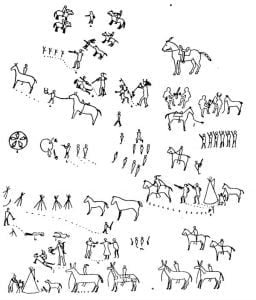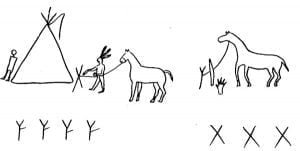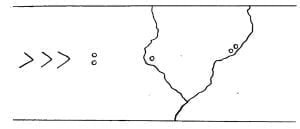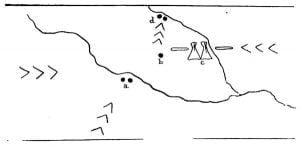
The term deed as used by us has the same social signif1cance as coup, a full discussion of which has been given by Grinnell. 1 Without going into details, it seems that among the Blackfoot, the capture of a weapon was the coup, or deed, rather than the formal striking of the enemy, though such was also taken into account. Our impression is, from what we have heard in the field, that there was no such formal development of the coup practice as among many other tribes. An old man relating his deeds seldom mentions scalps but dwells upon the number of guns, horses, etc. captured; whereas, according to our observation, a Dakota boasts of his wounds, enemies slain and coups. However, heraldry was a prominent feature in Blackfoot life. By this term, we mean those conventions by which deeds are recorded and accredited, with their social privileges and responsibilities. Anyone with such recognized deeds is likely to be called upon to name a child, to perform special services in social functions as well as specific parts of ritualistic ceremonies. In all cases of this kind the warrior comes forward and in a loud voice states what deed or deeds he has performed and immediately renders the required service. For this, he may receive presents unless the occasion is one of special honor. In theory, at least, the formal announcement is a kind of challenge for contradiction by any of the assembly in so far that it implies the eligibility of him who makes it. Women do not ordinarily perform such deeds but often recount the embroidering of robes, their resistance of temptation, etc., when about to perform some ceremonial function, a truly analogous practice.
As elsewhere, the graphic recording of deeds was chiefly by picture writing, upon robes, back-walls and the outsides of tipis. A few might be indicated upon leggings, but in general, garments were not considered the place for such records. The outside and inside of the tipi were the conventional places. Good examples of this are still to be seen. An unusual tipi was collected by the writer in 1903, bearing several hundred figures, representing sixty-six distinct deeds most of which were performed by seven Piegan then living. The tipi was in reality one of the “painted lodges” to be discussed under another head, but may be considered here merely as a good example of picture writing and heraldry.

In the sketches, Fig. 1 is a small vertical section of the tipi cover. Its entire circumference to about half the height is one continuous array of sketches. From this series a number of typical groups were reassembled in Fig. 2. Beginning at the top in Fig. 1, we have Bear Chief (a) on foot surprised by Assiniboine Indians but he escaped; (b) Double Runner cut loose four horses; (c) Double Runner captures a Gros Ventre boy; (d) Double Runner and a companion encounter and kill two Gros Ventre, he taking a lance from one; (e) even while a boy Double Runner picked up a war-bonnet dropped by a fleeing Gros Ventre which in the system counts as a deed; (f) as a man he has two adventures with Crow Indians, taking a gun from one; (g) he, as leader, met five Flathead in a pit and killed them; (h) a Cree took shelter in some cherry brush in a hole, but Big Nose went in for him; (i) not completely shown, but representing a Cree Indian killed while running off Piegan horses; (j) Double runner, carrying a medicine pipe, took a bow from a Gros Ventre and then killed him; (k) Double Runner took a shield and a horse from a Crow tipi, a dog barked and he was hotly pursued; (m) ke killed two Gros Ventre and took two guns (n) he captured a Gros Ventre woman and a boy; (o) he took four mules. From this sample, it will be noted that a great deal is left for the memory, though a little practice will enable one to determine the character of the exploit suggesting each drawing. 2 Fig. 2 needs less comment as the technical aspect of the work speaks for itself. The large man with a pipe is symbolic of the vision in which this type of tipi had its inception and, hence, belongs in a different category. The drawing was done by a number of individuals; in some cases, by the hero of the exploits, but often by a young man under his exploit suggesting each drawing. Fig. 2 needs less comment as technical aspect of the work speaks for itself. The large man with a pipe is symbolic of the vision in which this type of tipi had its inception and, hence, belongs ina different category. The drawing ws done by a number of individuals; in some cases, by the hero of the exploits, but often by a young man under his immediate direction. This is obvious in the varying degree in execution and conventionality, the range of which is adequately shown in the sketches. When considered as a system of recording deeds, it appears that much is left to the whim of the artist, but that certain general modes of suggesting common types of adventure are recognized and allowed to control the composition to such an extent that even a stranger may interpret the sketches with confidence. Of course, the function of such writing is to objectify the formal recounting of deeds, only such performances as are so recognized and carry with them social and ceremonial values being considered worthy of a place in the series.
From the many examples collected, we selected the following more or less conventionalized symbols:

Wounds received or given are indicated by a black spot with a dash of red for bleeding. Enemies killed, when not fully pictured, are represented by a row of skeleton figures as in Fig. 3a, a form always used in heraldic horse decorations. In the pictured form, death is often indicated by three wounds – in the head, heart and thigh, Fig. 3b. A scalp taken is symbolized by human hair and white weasel skin, except in painting when the symbol is as in Fig. 3c.
The capture of the enemies’ property, or a deed, is indicated by pictures of the objects recognized as worth considering. While naturally, there is difference of opinion, the following may be taken as the approximate list of captures conferring ceremonial rights:-horses, guns, shields, lances, bows and quivers, shot-pouches and powder horns, daggers, war-bonnets, and all medicine objects. The following order or rank, was given by an informant recognized by the Piegan as an authority in heraldry: gun, lance, bow, the enemy’s life, cutting a horse loose from a tipi, leading a war party, acting as a scout, shields, war-bonnets, a medicine pipe, and driving off loose horses. The most significant point is that while the life of an enemy is fourth, the capture of his gun is first. When a man was seen to fall with a gun, it was not unusual for one or more young men to rush boldly out to snatch the prize. To ride up, jerk a gun from an enemy’s hand and get away without injury to either party was the greatest deed possible. While in picturing such deeds realistic forms are used, as the symbol for a shield (Fig. 3d), they are often greatly conventionalized. Blankets, if counted, are shown as rectangles with one or two cross lines for the stripes on most trade blankets. Horses taken in open fight, when not pictured, are represented by track symbols, Fig. 5d and under the sketch of a mule in Fig. 1. The rectangular variant as found among many other tribes is not used as an equivalent.

Stealing a horse tied up in the enemies’ camp is a deed of special importance and naturally has a definite symbolism. This case is of some interest here because we find among our collection practically all the steps between the full pictured form and the bare symbol. Thus, we find drawings showing the adventurer cutting loose horses picketed near the tipis, Fig. 4; again, the cutting represented by a knife and a hand, the pickets alone representing the horses so taken, and finally, a series of crossed lines. The last is the simplest form but may be said to be an alternate with the preceding one, some persons representing the picket stake one way, some the other. The Hidatsa 3 are reported to use the crossed lines for a coup and the Teton use it as a rescue symbol (a coup saved from the enemy) ; hence, its substitution in Blackfoot records for the more realistic form of picket stake may have been due to suggestion.

A war party entrenched is indicated by a circle (Fig. 5c) ; sheltered in a wind brake, by an open circle (Fig. 2). A camp may be represented by a series of tripods, signs for tipis (Fig. 1). Two functions of the warpath are honored by distinct symbols; that of leader and scout. The symbol for leader is shown in Fig. 5a and is given once for each party led. In like manner, the sign in Fig. 5b indicates having been detailed as a scout. The origin of these cannot be definitely traced, but the second is said to be a diagrammatic representation of the course taken by a scout with reference to the main body. Thus the curve represents the war party waiting and the zigzag line of the course always taken by the scout to conceal their true position. This seems probable, but no rational theory for the origin of the leader’s sign was encountered.
The coup stick, striped like a barber’s pole, used by the Cheyenne, seems not to have been known among the Blackfoot except its analogous form in a boy’s game. The Dakota stick made by binding together two long rods with spiral decorations and four pendants of feathers with scalp locks was seen in the hands of an old man; he however frankly avowed having made it in imitation of those seen by him when visiting the Assiniboine.
In a general way, it appears that the Blackfoot show some individuality in the conventions of picture writing. Some data we collected from the Gros Ventre show many of the same forms, however, and in the absence of good data from the Crow and other neighboring tribes, it may be that this individuality is more apparent than real. On the other hand, the Black- foot make little use of such writing for the presentation of religious experiences as is the case among many Central Algonkin tribes and to a much less degree among the Dakota. While the Dakota have developed some heraldic symbols as conventional as those just described by us, they have, in addition, a very complex and highly developed feather symbolism, a feature almost lacking among the Blackfoot. Yet, the latter showed a tendency to use the white weasel skins for the same purpose. More than this can scarcely be said until additional data are at hand.

In this connection, it may be well to note that by a system of signs, a war party left definite information for the guidance of stragglers or other parties of their tribe on similar errands. On leaving a campsite, a willow bent V-like was stuck in the ground, the apex in the direction taken; if the distance to the next camping place was small, the angle was quite acute, etc. Another sign, used chiefly on the trail, was the mark of a travois, or two converging lines, the apex toward the direction taken. Indeed, the twig is spoken of as a travois sign. Explicit directions were often left for a second party by a kind of map marked in the sand or in bare earth. A sketch by the writer from such a map made at his request is shown in Fig. 6. Two branches of a river are represented easily recognized by one having knowledge of the country. The travois marks indicate the direction of movement. Pebbles painted black or pieces of charcoal mark the proposed camping places, the number in each case indicating the length of stop. Thus, the sketch would imply that the next camp would be one day’s journey from the nearest river; whence, after a stay of two nights, they camped one night on the nearest fork and two nights on the second. To indicate that they were joined by a second party, the travois signs are used to denote two paths converging on a camp site. A sketch giving more details is shown in Fig. 7. By the travois signs leading to a we know that two parties of Blackfoot combined and camped two nights, thence moved to a second camp, b. While here, they met and fought enemies, indicated by two sticks painted red. Between the two sticks are two bones (shoulder blades) upon which the result of the engagement is pictured. Then the party moved on to d where this sketch was left.

In cases where the stops were by day and travel by night, yellow pebbles were used instead of black. Mountains were indicated by small heaps of pebbles. Marks were often made on stones and other objects along the trail. In case a peaceful meeting occurred, instead of the red painted sticks, black ones were chewed on one end and tobacco tied on the other. The practical value of all these marks is obvious. When a war party was over due, search was made by following the trail whence from the signs its career could be determined, even to the identity of the wounded or killed, etc.
We did not gather much information as to signaling codes, though the system seems to have been highly developed. When a war party returned the members paused for a time upon a hill in sight of the camp until attention to them was noted. 4 Then, if a victory was won at small cost they sang songs for a while and came to camp slowly. If the leader or an important man was killed, a robe was held up on a stick and then dropped. If ordinary men were killed, one of the party stepped aside and threw down a robe, once for each. For a wounded leader, a robe was held aloft but not dropped. They then entered the camp silently while the women began wailing and performed the usual acts of mourning.
Citations:
- Grinnell, George Bird. Blackfoot Lodge Tales. New York, 1904, p. 248. Also American Anthropologist, Vol. 12, p. 296.[
]
- For a complete series for one individual with illustration, see Maclean, John. The Gesture Language of the Blackfeet. (Transactions, Canadian Institute, Vol. 5. Toronto, 1898), p. 119.[
]
- Hoffman, Walter James. The Beginnings of Writing. New York, 1895, p. 73; Maximilian, Prince of Wied. Early Western Travels, 1748-1846. Edited by Reuben Gold Thwaites. Cleveland, 1906, Vol. 23, 287.[
]
- See Maximilian, Prince of Wied. Early Western Travels, 1748-1846. Edited by Reuben Gold Thwaites. Cleveland, 1906, Vol. 23. 118[
]
